



















|
 |
|
 |

The Saba can draw upon various troop types from line infantry to ranged troops to cavalry, although very few have heavy armor, which can be drawback against the northern empires, although the high morale and fighting prowess makes up for lack of armor.
Dorkim Ezra'him (Sabaean Levy Spearmen)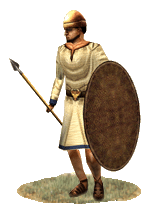 These urbanites are the core of Sabaean society and as such it is no surprise that they provide the bedrock of the Sabaean military machine. Armed with sturdy spears and protected by good quality helmets and hardy camel hide leather shields these men are far more capable than their lighter counterparts in tribal levies of holding the line of battle. Further, their religious fervor makes them more reliable in battle than many citizen forces. Still, their more sheltered urban existence makes them less able to bear the rigors of desert warfare than their nomadic fellows and their armament is not as heavy as comparable troops fielded by other states. A wise general will be mindful of both the strengths and weaknesses of these troops, the Sabaean will never recover their past splendor without their sweat and blood, but only when used in proper roles will their sacrifices be meaningful. These urbanites are the core of Sabaean society and as such it is no surprise that they provide the bedrock of the Sabaean military machine. Armed with sturdy spears and protected by good quality helmets and hardy camel hide leather shields these men are far more capable than their lighter counterparts in tribal levies of holding the line of battle. Further, their religious fervor makes them more reliable in battle than many citizen forces. Still, their more sheltered urban existence makes them less able to bear the rigors of desert warfare than their nomadic fellows and their armament is not as heavy as comparable troops fielded by other states. A wise general will be mindful of both the strengths and weaknesses of these troops, the Sabaean will never recover their past splendor without their sweat and blood, but only when used in proper roles will their sacrifices be meaningful.
Historically, the Sabaean urban population was the most substantial component of their impressive regular military. In Sabaean society, religion was among the most immediate concerns of the average citizen. Their years revolved around the Festival of Almaqah, while their days were first geared towards frequent sacrifices and offerings to him, administered by his all pervasive High Priesthood. Everywhere they might go, an agent of the High Priesthood could be encountered, and in everything they do, some aspect of their work can be seen, giving such citizens a massive psychological stake in their traditional religion. This simple dedication and familiarity made these citizens among the most loyal soldiers of the Sabaean infantry, beyond reproach and angered at the very prospect of foreign encroachment upon their childhood religion.
Bnei Shevet Aravim (Arabian Light Infantry)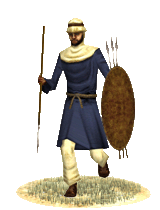 These lightly armed men are not much to look at, clad in simple attire and armed with the most rudimentary of weapons, a spear and shield, but they are far more capable soldiers than first glance would indicate. Exceedingly loyal to their Sabaean overlords they are much more reliable than their eastern levy counterparts and their experience in years of both tribal skirmishing and warfare on behalf of their Sabaean rulers has made them into warriors of surprising merit and skill. These lightly armed men are not much to look at, clad in simple attire and armed with the most rudimentary of weapons, a spear and shield, but they are far more capable soldiers than first glance would indicate. Exceedingly loyal to their Sabaean overlords they are much more reliable than their eastern levy counterparts and their experience in years of both tribal skirmishing and warfare on behalf of their Sabaean rulers has made them into warriors of surprising merit and skill.
Historically, the bulk of the Sabaean medium infantry line was levied from the Arab and Bedouin peoples under their direct or nominal rule, many of them serving as regulars, though most were recruited sporadically by agents of the Sabaean King. Their minor tribes and settlements had a history of loyalty to the Sabaeans, having fought alongside them and been under their rule to various extents for centuries, most of them coming to accept their religious practices ages ago. They were hardy veterans of numerous conflicts, with relatives who could in all likelihood say the same, generally invested in their ruler's cause and sympathetic to their often easy government.
Arab Slingers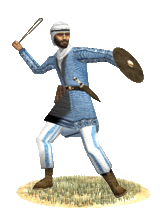 Slingers are common in Arabian armies, being levied from the nomadic tribes. These men are mostly lower class herders. The tribesmen are not wealthy, so they march to war in just their simple garments, a simple shield and their own, often homemade sling, in addition to a dagger for self-defense. In battle, the slingers should be used as light skirmishers, who will rush forward against the enemy to pepper them with stones, only to flee when threatened. These slingers should never be expected to fare well in melee. Slingers are common in Arabian armies, being levied from the nomadic tribes. These men are mostly lower class herders. The tribesmen are not wealthy, so they march to war in just their simple garments, a simple shield and their own, often homemade sling, in addition to a dagger for self-defense. In battle, the slingers should be used as light skirmishers, who will rush forward against the enemy to pepper them with stones, only to flee when threatened. These slingers should never be expected to fare well in melee.
Historically, slingers seem to have been used in almost all corners of the world in some sort and Arabia was no exception. Slings are very easy and cheap to make, and yet they are a respectable weapon. It is for this reason that they were so prevalent among the poorer Arabian tribes. The Arabian city-states, like Sab’yn levied slingers from the subject nomadic tribes to augment their own armies and these men were drawn from the lower class herders whose only task during peace was to guard the herds from predators. This in return meant they had enough experience with a sling to be a threat on the battlefield.
Sabaean Archers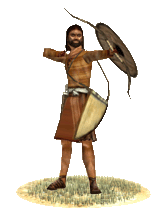 Sabaean archers are a common sight in Sabaean garrisons and large armies. Even though archery is not frowned upon, these men are drawn from the lower urban classes and from the agriculturalists in times of war. They carry nothing but their own clothes and bows to war in addition to a small shield and dagger should they be caught in melee, which any general should try to avoid. Sabaean archers are not renown for their archery even though it is a part of Sabaean life be it a noble or a peasant one, so they should only be counted on to weaken the enemies, not to severely reduce their numbers like the Syrian and Iranian archers can be capable off. Sabaean archers are a common sight in Sabaean garrisons and large armies. Even though archery is not frowned upon, these men are drawn from the lower urban classes and from the agriculturalists in times of war. They carry nothing but their own clothes and bows to war in addition to a small shield and dagger should they be caught in melee, which any general should try to avoid. Sabaean archers are not renown for their archery even though it is a part of Sabaean life be it a noble or a peasant one, so they should only be counted on to weaken the enemies, not to severely reduce their numbers like the Syrian and Iranian archers can be capable off.
Historically, hunting with bows was a popular sport among the Sabaean nobility and a fact of life among the peasantry. With the advent of large scale defensive fortifications in the eight century BC the use of bow as a defensive weapon probably became fairly common in southern Arabia. Sabaeans though seems not to have had a reputation as good bowmen and archers were most probably used to simply bolster an army’s numbers or for defending walls.
Parashim Aravim Meguiasim (Arabian Light Cavalry)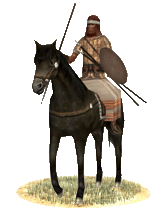 The majority of Saba’s cavalry arm was drawn not from her urban population, who were more often called on to serve as the center of the line of battle, but from her tribal allies. The tribes that provided these cavalry forces were generally nomadic in lifestyle and as such provided men who spent more time mounted than on foot, even if the mount was often a camel rather than a horse. In battle these men provide a highly skilled light cavalry contingent exceedingly capable in the roles of skirmishing, pursuit, and harassment. When coupled with the smaller contingent on medium cavalry fielded by Saba’s urban population they can also deliver a devastating charge to the flanks or rear of the enemy battle-line, but should not be expected to fulfill the role of shock cavalry on their own. The majority of Saba’s cavalry arm was drawn not from her urban population, who were more often called on to serve as the center of the line of battle, but from her tribal allies. The tribes that provided these cavalry forces were generally nomadic in lifestyle and as such provided men who spent more time mounted than on foot, even if the mount was often a camel rather than a horse. In battle these men provide a highly skilled light cavalry contingent exceedingly capable in the roles of skirmishing, pursuit, and harassment. When coupled with the smaller contingent on medium cavalry fielded by Saba’s urban population they can also deliver a devastating charge to the flanks or rear of the enemy battle-line, but should not be expected to fulfill the role of shock cavalry on their own.
Historically, the Arabs were a far-flung people, raised on the backs of camels and horses while crossing desert as traders or living the rugged life of the nomad. While they might generally have chosen the high perch of a camel for their travels, in battle, their horses were the prefered mount. Brought literally into a new saddle, they excelled in combat, well-served by the balance learned from riding a camel, and despite their light armor and armament, fought with skill - though not always with dedication.
Giusim Aravim Tsfonim (Arabian Light Archer-Spearmen)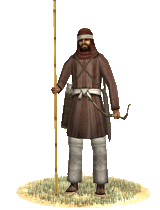 These lightly armored Arabian archers are versatile troops. Equipped with bows and spears, these men are able to provide an army with ranged support while still capable of quickly switching to light spearmen. The versatility of these troops is their main advantage, however, and they should be expected to hold out for too long in a melee against a disciplined opponent. These lightly armored Arabian archers are versatile troops. Equipped with bows and spears, these men are able to provide an army with ranged support while still capable of quickly switching to light spearmen. The versatility of these troops is their main advantage, however, and they should be expected to hold out for too long in a melee against a disciplined opponent.
Historically, the settled and wandering tribes of Arabs and Bedouins North of the Sabaean heartlands were a sporadic source of troops for the larger kingdoms of the South. Despite a thin and widely spread population, these troops formed a substantial component of the Sabaean irregulars, and were organized quite ingeniously. The Sabaean King, and High Priesthood in regions with sympathetic religious practices, organized small tribal councils to administer the levying process within particular territories, during which even their less organized troops could be trained and equipped to greater effect.
Abbir Ezra'him (Sabean Medium Cavalry)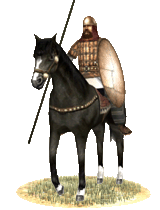 Historically, the Sabaean urban population was, besides Arab levies, the only other major component of their cavalry divisions. Hailing from a highly urbanized society, these men hailed from both small and large settlements, many helping to work royal land grants, a few riding horses provided by stables owned by their local High Priesthood, and some even enrolled in the forces of semi-independent city commanders. They were skilled veterans, their service during Sabaean campaigns leading them into the rugged mountains North of their well watered and fertile lands, fighting raiders and marauding tribes almost as a way of life. For this service, their pay was good and their lives away from campaign were fairly comfortable, but their strong association with the High Priesthood from engrained childhood perceptions to livelong economic and social relationships, leave their loyalty and dedication beyond reproach. Historically, the Sabaean urban population was, besides Arab levies, the only other major component of their cavalry divisions. Hailing from a highly urbanized society, these men hailed from both small and large settlements, many helping to work royal land grants, a few riding horses provided by stables owned by their local High Priesthood, and some even enrolled in the forces of semi-independent city commanders. They were skilled veterans, their service during Sabaean campaigns leading them into the rugged mountains North of their well watered and fertile lands, fighting raiders and marauding tribes almost as a way of life. For this service, their pay was good and their lives away from campaign were fairly comfortable, but their strong association with the High Priesthood from engrained childhood perceptions to livelong economic and social relationships, leave their loyalty and dedication beyond reproach.
Lo'hamim Azzilim (Sabean Noble Infantry)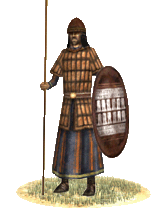 This tough, heavily armored infantry is the cream of Southern Arabian nobility and despite the land’s reputation for the production of aromatics these are not perfume wearing effeminates who can be easily brushed aside. Armored in good quality chain, tough leather shields and armed with thin but sturdy swords these men can be relied on to hold their own against all but the best heavy infantry. This tough, heavily armored infantry is the cream of Southern Arabian nobility and despite the land’s reputation for the production of aromatics these are not perfume wearing effeminates who can be easily brushed aside. Armored in good quality chain, tough leather shields and armed with thin but sturdy swords these men can be relied on to hold their own against all but the best heavy infantry.
Historically, the wealthy of elite of the great cities of Southern Arabia went to war clad in heavy armor and provided the backbone of the Khamis (national troops) that a city called upon in time of war. Thier sturdy chain armor was made of either bronze or iron, with bronze being more common as both copper and scorching sun were common in Arabia. The poets of later day Arabia were at their most elegant when describing the qualities of a fine suit of mail often saying that such a coat will ripple like a pool blown by wind and glitter like lightning. The thin and supple sword and tough camel hide shield, while not nearly so highly praised in poetry, are equally formidable parts of their arsenal.
Giborei haMele'h (Sabaean Bodyguard Infantry)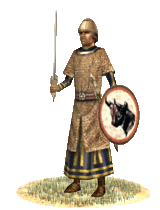 Historically, the institution of the Sabaean Kingship wasn't always the sole authority over the Union's military forces, many being raised through tribal councils outside their main urban holdings, but it did hold complete sway over the King's Elites. These men, though devoted to the Sabaean High Priesthood and their ancient city-gods, were personally loyal to their king - from whom the cost of their equipment and training was exclusively drawn. In the days when the Sabaean King controlled the High Priesthood, they served as temple guardsmen in addition to his personal escorts, marching as a ceremonial guard and as an elite corps of regulars in battle. They were superb melee warriors, trained for the most difficult assaults and confrontations, and fiercely loyal to their king in all fortunes. Such men were the crux of a Sabaean battle line, around which all tactics and strategies were formed, and before which most enemies were driven. Historically, the institution of the Sabaean Kingship wasn't always the sole authority over the Union's military forces, many being raised through tribal councils outside their main urban holdings, but it did hold complete sway over the King's Elites. These men, though devoted to the Sabaean High Priesthood and their ancient city-gods, were personally loyal to their king - from whom the cost of their equipment and training was exclusively drawn. In the days when the Sabaean King controlled the High Priesthood, they served as temple guardsmen in addition to his personal escorts, marching as a ceremonial guard and as an elite corps of regulars in battle. They were superb melee warriors, trained for the most difficult assaults and confrontations, and fiercely loyal to their king in all fortunes. Such men were the crux of a Sabaean battle line, around which all tactics and strategies were formed, and before which most enemies were driven.
Giusim Aravim 'im Garzenim (Red Sea Light Infantry)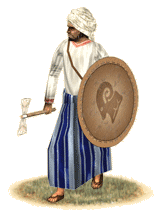 When the men of the Red Sea Coast are called to war they fight in a manner centuries old. Armed with the traditional balta harbiye, a double edged axe, and light wickerwork and leather shields, these men form a light and unruly levy. While they are not the toughest or most reliable troops on the field of battle they have been weathered and hardened by their inhospitable homeland, and their ability to survive, and thrive, in the desert climes of their native land is their greatest asset, even on the battlefield. When the men of the Red Sea Coast are called to war they fight in a manner centuries old. Armed with the traditional balta harbiye, a double edged axe, and light wickerwork and leather shields, these men form a light and unruly levy. While they are not the toughest or most reliable troops on the field of battle they have been weathered and hardened by their inhospitable homeland, and their ability to survive, and thrive, in the desert climes of their native land is their greatest asset, even on the battlefield.
Historically, the coast of the Red Sea was a comparatively populous and successful region, dotted with scattered towns and mountain settlements, despite widely spaced rivers and the lack of an agricultural infrastructure as old as in Saba to the South. These coastal peoples were a fairly hardy folk, used to more rugged territory and veterans of minor city conflicts, and wars that called them up as mercenaries or levies for larger armies. This background served them well in combat, and though not imbued with the same loyalty and religious fervor that the more traditional tribal allies and levies of the Sabaeans possessed, they were a strong shock infantry when their dedication was not overly taxed.
Erínamesh ana-Arabim (East Coast Levies)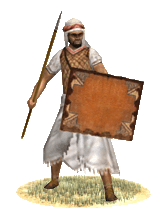 These raiders and pirates dominate the military stage of Eastern Arabia around Gerrha and historical Oman. In nature, they are light infantry equipped with padded armour worn over their dishdasha tunics, giving them some protection against arrow-fire. They carry shields made of wicker, osier and reed as well as that of hides and leather. They are swift, agile and their spears give them some edge over light cavalry. As they are more accustomed to the hot climate, these pirates and raiders make excellent desert warriors, albeit they are neither very disciplined or formally trained; Their loyalty is only a measure of the wages ordained by their paymaster. These raiders and pirates dominate the military stage of Eastern Arabia around Gerrha and historical Oman. In nature, they are light infantry equipped with padded armour worn over their dishdasha tunics, giving them some protection against arrow-fire. They carry shields made of wicker, osier and reed as well as that of hides and leather. They are swift, agile and their spears give them some edge over light cavalry. As they are more accustomed to the hot climate, these pirates and raiders make excellent desert warriors, albeit they are neither very disciplined or formally trained; Their loyalty is only a measure of the wages ordained by their paymaster.
Historically, the area around historical Gerrha and Oman, (Called "Mâzûn", by the subsequent Parthians and the Sassanians who came to dominate the political scene around the entire Persian Gulf) bolstered such warriors in an environment that demanded skill in naval trade and a tough bulwark adept in desert warfare. The natives of Gerrha were heavily influenced by Chaldaeans who were said to have built the city of Gerrha "entirely on blocks and slabs of salt" while the natives of Oman were more influenced by the Iranians over the strait of Hôrmûz. These Arabians were proficient in trading and in sea-faring, extending their influence as far as Dravidia in southern India, rivalling against the Nabataean Arabs to the west. It would be these Arabs who later became the stock of the later Lakhmid (Muntherid) dynasts, the powerful vassals of the Sassanians, marking a boundary between the sedentary and cosmopolitan Arabs and those who still adhered to nomadic principles.
Aithiopikoi Toxotai (Ethiopian Archers)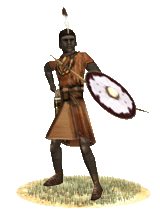 Skirmishers form the backbone of any Ethiopian army, especially bowmen. Hunting being an important part in Ethiopian life, at least in the interior plains and mountains means there is no shortage of able archers to call upon from the Ethiopian lands. In addition to their bow, every archer also carries a club for close combat should it happen, and they also carry shields. Depending on from which region these archers are raised, some might march to war in simple tunics while others prefer to fight without. As long as these archers are used in their intended battlefield role, that of archery they will do their duty well and should they be caught in close combat their clubs & shields will help them a bit, but a wise general should not expect these men to hold out in any prolonged melee. Skirmishers form the backbone of any Ethiopian army, especially bowmen. Hunting being an important part in Ethiopian life, at least in the interior plains and mountains means there is no shortage of able archers to call upon from the Ethiopian lands. In addition to their bow, every archer also carries a club for close combat should it happen, and they also carry shields. Depending on from which region these archers are raised, some might march to war in simple tunics while others prefer to fight without. As long as these archers are used in their intended battlefield role, that of archery they will do their duty well and should they be caught in close combat their clubs & shields will help them a bit, but a wise general should not expect these men to hold out in any prolonged melee.
Historically, ancient Ethiopia (encompassing modern day Eritrea and northern Ethiopia) was at this time made up of many smaller kingdoms that waged wars against each other, but also against any foreign invaders, like the Nubians, Hellenes and Sabaeans. There were basically three main regions in ancient Ethiopia; the coastal lowlands along the Erythrean Sea, the interior plains and the mountains separating them. The coastal lowlands seem to have been the most prosperous and were often raided by the mountain kingdoms. Most evidence indicates that the Ethiopians living along the Erythrean Sea were the most urbanized and also the most influenced by foreigners who established colonies and trade posts along the coast, like the Hellenes and Sabaeans and when it came to the latter, adopted their religious practices, which was a legacy of the earlier Sabaean rule in Ethiopia or D’mt as it was also called, although to which extent Ethiopia was ruled or if it was ruled at all by Sab’yn is a matter of debate. There are also evidences of Judaism being prevalent in ancient Ethiopia due to archaeological findings of temples and altar stones from 500 BC on, resembling ancient Jewish temples and sacrificial altars from 800-600 BC.
Ethiopian warfare at this time seems to have been similar to that of their Nubian neighbours, but there were regional variations in arms and armor when it came to materials used. The dominant type was skirmishers armed with either javelins or bows, and sometimes on horseback. They would also be armed with clubs for close combat. Spearmen were also used and the coastal peoples also fielded small, but elite contingents of swordsmen, either influenced or equipped by foreigners, serving often as bodyguards for kings or chieftains.
Hanatim Kushim (Ethiopian Light Spearmen)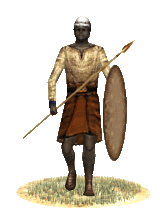 Even though archery and skirmishing is the mainstay method of war in Ethiopia, close combat also plays an important part, in which spearmen are used. These men are equipped with spears, shields and helmets which quality might change depending who is levying these troops, either it be a native king of the many small mountain kingdoms or a Sabaean general recruiting troops for a campaign. These spearmen can be expected to do their job well as light line infantry, but their lack of armor means they will have problems facing heavier equipped infantry and might be at a disadvantage against missile troops firing from an angle not covered by their shields. Even though archery and skirmishing is the mainstay method of war in Ethiopia, close combat also plays an important part, in which spearmen are used. These men are equipped with spears, shields and helmets which quality might change depending who is levying these troops, either it be a native king of the many small mountain kingdoms or a Sabaean general recruiting troops for a campaign. These spearmen can be expected to do their job well as light line infantry, but their lack of armor means they will have problems facing heavier equipped infantry and might be at a disadvantage against missile troops firing from an angle not covered by their shields.
Historically, ancient Ethiopia (encompassing modern day Eritrea and northern Ethiopia) was at this time made up of many smaller kingdoms that waged wars against each other, but also against any foreign invaders, like the Nubians, Hellenes and Sabaeans. There were basically three main regions in ancient Ethiopia; the coastal lowlands along the Erythrean Sea, the interior plains and the mountains separating them. The coastal lowlands seem to have been the most prosperous and were often raided by the mountain kingdoms. Most evidence indicates that the Ethiopians living along the Erythrean Sea were the most urbanized and also the most influenced by foreigners who established colonies and trade posts along the coast, like the Hellenes and Sabaeans and when it came to the latter, adopted their religious practices, which was a legacy of the earlier Sabaean rule in Ethiopia or D’mt as it was also called, although to which extent Ethiopia was ruled or if it was ruled at all by Sab’yn is a matter of debate. There are also evidences of Judaism being prevalent in ancient Ethiopia due to archaeological findings of temples and altar stones from 500 BC on, resembling ancient Jewish temples and sacrificial altars from 800-600 BC.
Ethiopian warfare at this time seems to have been similar to that of their Nubian neighbours, but there were regional variations in arms and armor when it came to materials used. The dominant type was skirmishers armed with either javelins or bows, and sometimes on horseback. They would also be armed with clubs for close combat. Spearmen were also used and the coastal peoples also fielded small, but elite contingents of swordsmen, either influenced or equipped by foreigners, serving often as bodyguards for kings or chieftains.
Aithiopikoi Machairophoroi (Ethiopian Swordsmen)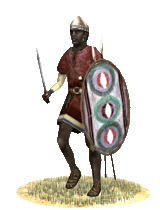 Ethiopian Swordsmen are in most cases raised from the population living along the coastlands of the Erythrean Sea by foreign overlords or Ethiopian rulers heavily influenced by foreigners and their ways. These men are equipped with helmets & shields only as body armor would only burden a soldier in the hot climate of Ethiopia. They also carry swords and javelins into battle. These men are the elite among Ethiopian troops, and can be expected to fulfil their role as assault infantry as long as properly used. Ethiopian Swordsmen are in most cases raised from the population living along the coastlands of the Erythrean Sea by foreign overlords or Ethiopian rulers heavily influenced by foreigners and their ways. These men are equipped with helmets & shields only as body armor would only burden a soldier in the hot climate of Ethiopia. They also carry swords and javelins into battle. These men are the elite among Ethiopian troops, and can be expected to fulfil their role as assault infantry as long as properly used.
Historically, ancient Ethiopia (encompassing modern day Eritrea and northern Ethiopia) was at this time made up of many smaller kingdoms that waged wars against each other, but also against any foreign invaders, like the Nubians, Hellenes and Sabaeans. There were basically three main regions in ancient Ethiopia; the coastal lowlands along the Erythrean Sea, the interior plains and the mountains separating them. The coastal lowlands seem to have been the most prosperous and were often raided by the mountain kingdoms. Most evidence indicates that the Ethiopians living along the Erythrean Sea were the most urbanized and also the most influenced by foreigners who established colonies and trade posts along the coast, like the Hellenes and Sabaeans and when it came to the latter, adopted their religious practices, which was a legacy of the earlier Sabaean rule in Ethiopia or D’mt as it was also called, although to which extent Ethiopia was ruled or if it was ruled at all by Sab’yn is a matter of debate. There are also evidences of Judaism being prevalent in ancient Ethiopia due to archaeological findings of temples and altar stones from 500 BC on, resembling ancient Jewish temples and sacrificial altars from 800-600 BC.
Ethiopian warfare at this time seems to have been similar to that of their Nubian neighbours, but there were regional variations in arms and armor when it came to materials used. The dominant type was skirmishers armed with either javelins or bows, and sometimes on horseback. They would also be armed with clubs for close combat. Spearmen were also used and the coastal peoples also fielded small, but elite contingents of swordsmen, either influenced or equipped by foreigners, serving often as bodyguards for kings or chieftains.
Aithiopikoi Hippeis (Ethiopian Cavalry) The Ethiopians living in the low coastlands share many cultural traits with the people of Sab’yn, including religious practices. These cavalrymen are drawn from these peoples and are often recruited from the higher ends of Ethiopian society, the families of the nobles and priests. They are equipped with lances and swords in addition to helmets and shields. In battle they can be expected to fight bravely, but as long as they are used properly. The Ethiopians living in the low coastlands share many cultural traits with the people of Sab’yn, including religious practices. These cavalrymen are drawn from these peoples and are often recruited from the higher ends of Ethiopian society, the families of the nobles and priests. They are equipped with lances and swords in addition to helmets and shields. In battle they can be expected to fight bravely, but as long as they are used properly.
Historically, ancient Ethiopia (encompassing modern day Eritrea and northern Ethiopia) was at this time made up of many smaller kingdoms that waged wars against each other, but also against any foreign invaders, like the Nubians, Hellenes and Sabaeans. There were basically three main regions in ancient Ethiopia; the coastal lowlands along the Erythrean Sea, the interior plains and the mountains separating them. The coastal lowlands seem to have been the most prosperous and were often raided by the mountain kingdoms. Most evidence indicates that the Ethiopians living along the Erythrean Sea were the most urbanized and also the most influenced by foreigners who established colonies and trade posts along the coast, like the Hellens and Sabaeans and when it came to the latter, adopted their religious practices, which was a legacy of the earlier Sabaean rule in Ethiopia or D’mt as it was also called, although to which extent Ethiopia was ruled or if it was ruled at all by Sab’yn is a matter of debate. There are also evidences of Judaism being prevalent in ancient Ethiopia due to archaeological findings of temples and altar stones from 500 BC on, resembling ancient Jewish temples and sacrificial altars from 800-600 BC.
Ethiopian warfare at this time seems to have been similar to that of their Nubian neighbours, but there were regional variations in arms and armor when it came to materials used. The dominant type was skirmishers armed with either javelins or bows, and sometimes on horseback. They would also be armed with clubs for close combat. Spearmen were also used and the coastal peoples also fielded small, but elite contingents of swordsmen, either influenced or equipped by foreigners, serving often as bodyguards for kings or chieftains. Ethiopians were accustomed to cavalry warfare, but only as skirmishers, which is why cavalrymen like these would only be raised by Sabaean influence or under Sabaean rule.
Hoplitai Troglodutikes (Red Sea Hoplites)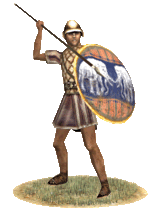 Hoplitai Troglodutikes (Erythraian Sea Hoplites) are mostly Hellenic colonists who were drawn to the Erythraian Sea coast. After initial exploration Ptolemaioi founded colonies in there to hunt elephants and trade with the natives and as far as India. Local garisson forces took part in those hunts and many of the veterans remained on those colonies after retiring. As in each Hellenic polis, a local force of hoplites would be summoned at time of need. Having completed the rigorous "ephebike askesis" they would be ready to fight against their enemies and as such the rigorous demands for citizenship have been lowered to whomever is available. The enemies aren't hoplites or Phallangitai. They are the skirmishers and spearmen of the Troglodytai, the fierce archers of Meroe and Inner Aithiopia, and maybe even the lightly armored but deadly Sabaioi. Hellenic discipline and courage can win the day, but not by underestimation of those enemies. Against those, while retaining the same offensive equipment, (spear and aspis shield), bronze muscle cuirass and linothorax have been dumped in favor of lighter quilted armour. It is easier to wear in the tropics as ancient Aigyptioi had proven. No pteryges, as they add to weight and can raise body temperature. A trusty "machaira" compliments their equipment too. Their helmet is an evolved Boiotian, the ideal helmet for providing some sort of eye protection in the desert and african coast. Their aspis has no bronze coating, relying on elephant skin instead. Natives had been using such an arrangement, for some time. Now Hoplitai Troglodutikes must do the same. Hoplitai Troglodutikes (Erythraian Sea Hoplites) are mostly Hellenic colonists who were drawn to the Erythraian Sea coast. After initial exploration Ptolemaioi founded colonies in there to hunt elephants and trade with the natives and as far as India. Local garisson forces took part in those hunts and many of the veterans remained on those colonies after retiring. As in each Hellenic polis, a local force of hoplites would be summoned at time of need. Having completed the rigorous "ephebike askesis" they would be ready to fight against their enemies and as such the rigorous demands for citizenship have been lowered to whomever is available. The enemies aren't hoplites or Phallangitai. They are the skirmishers and spearmen of the Troglodytai, the fierce archers of Meroe and Inner Aithiopia, and maybe even the lightly armored but deadly Sabaioi. Hellenic discipline and courage can win the day, but not by underestimation of those enemies. Against those, while retaining the same offensive equipment, (spear and aspis shield), bronze muscle cuirass and linothorax have been dumped in favor of lighter quilted armour. It is easier to wear in the tropics as ancient Aigyptioi had proven. No pteryges, as they add to weight and can raise body temperature. A trusty "machaira" compliments their equipment too. Their helmet is an evolved Boiotian, the ideal helmet for providing some sort of eye protection in the desert and african coast. Their aspis has no bronze coating, relying on elephant skin instead. Natives had been using such an arrangement, for some time. Now Hoplitai Troglodutikes must do the same.
Historically Ptolemaioi were very interested in the southern regions of their domain. Akte Troglodutike or the coast of the Troglodutes was perhaps the "wild, unexplored" frontier of the time. The rising elephant hunts as well as the trade with Sabaioi and Indoi, led to the founding of a series of Colonies, with Filotera, "founded by Satyr [a Ptolemaioi general] when he was sent hunting elephants in Troglodytiki" (Strabo,16,4-5) being the first. Soon enough, Arsinoe Troglodytiki, Berenike Troglodytiki, Ptolemais of the Elephantotheron (Elephant hunters) were founded. As frontiermen always do, those people cared more for what someone could do, not the purity of his Hellenic blood. Thus Hellenised Aigyptians and other nationals could be there and perfectly fit in. However rich and promising their situation was, their enemies were at the doors as to a Troglodyte which many of them were, the Colonists were godly rich. The local hoplites fight as ekdromoi mostly, since this is the only way they can effectively deal with the fluid battlefield environment in that area. Colonies in that region existed for many centuries and that was due, in no small part to the ability of their inhabitants to defend them.
|
 |
|
 |






















|